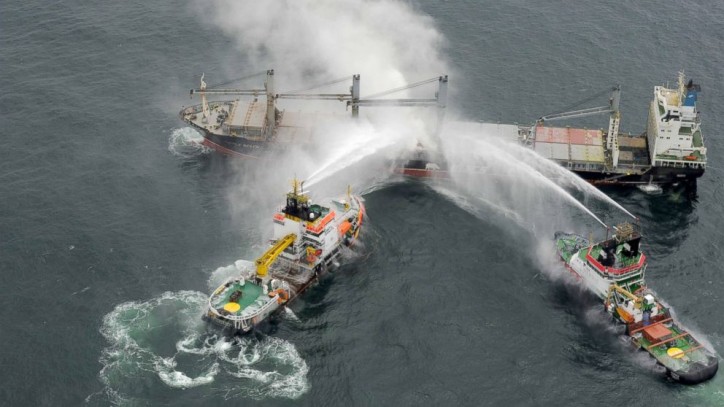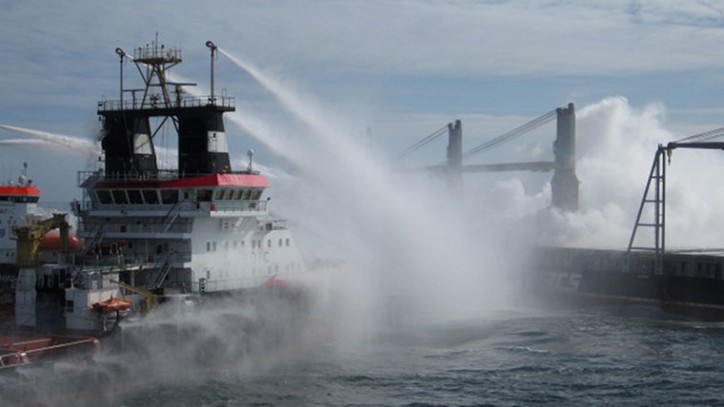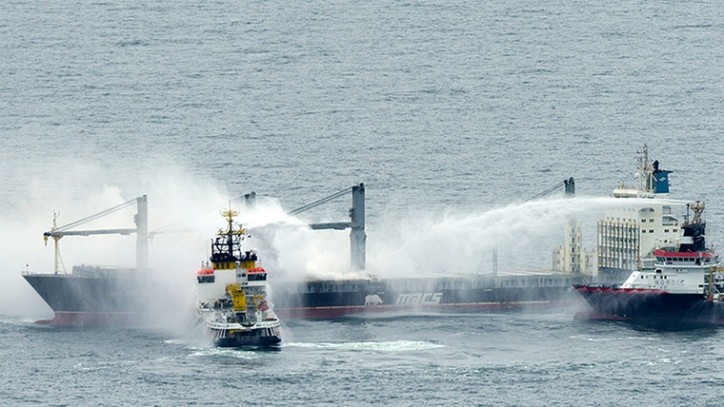Source: MV Purple Beach http://www.shipwrecklog.com/log/2015/05/purple-beach/
Introduction
It's been just over a week since I published Part 1 of the blog on Marine Insurance. Part 2 will feature the History of Maritime Shipping and Marine Insurance. History is important as Empires and Countries have risen, flourished and floundered on account of the shipping trade. From ships carrying a few tons of high-value products 7,000 years ago, today we have ships carrying as much as 18,000 containers in a ship. The value of goods at risk has increased exponentially. Marine Insurance has developed from Sumerian times, through the Phoenician, Arab and Chinese sea-farers, and then by British, Dutch, Spanish, German, Italian and Portuguese traders.
I seem to be developing sea legs yet, I'm no sailor. I've been on ships, monitored off-loading and on-loading operations. My expeditions has been limited to visits to Marine Parks off the Kenyan coast. I've not ventured into the deep dark blue-green sea.
Why are Kenyan's so reluctant to take our Marine Insurance? This seems to have been the subject of a study by the Association of Kenya Insurers. In simple language, the study questioned why Kenyan Business people, particularly the SME sector, doesn't take advantage of:
- Marine Hull Insurance
- Marine Cargo Insurance
"Enforcement" seems the theme but, it's really up to educating SME Business.
My take is that "Awareness" will improve as the SMEs grow, and learn hard lessons from their own losses and, how big business insures their transactions. It's a natural learning curve. Kenyans love cutting corners, even insuring a Range Rover on Third Party!?! They know about the Traffic Act, but nothing about the Marine Insurance Act. It also has to do Business People "hustling" to learn the ropes, many a time, with no mentors.
"Mercantilism" as an old economic policy by which countries regulated commerce to ensure the country's wealth was amassed by exporting more than they imported. It was the principal driver of advances in shipping in terms of technology, distance and carrying capacity. Countries and Empires imposed regulations including monopoly policies.
Globalisation economics is the process of the increasing integration of markets in the world economy. This is the world in which we live in, wearing cloth material milled in Vietnam and tailored in London, a watch from Switzerland, car from Japan, phone from China, and a gemstone from Kenya.
Over now to the Purple Beach saga...
MV Purple Beach, a 33,722 dwt multi-purpose container vessel, caught fire in the North Sea whilst enroute from Immingham, UK to Brake, Germany carrying 6,000 MT of fertiliser. The 192m vessel was built in 1998 (17 years old) and, is currently sailing under a Marshall Island Flag.
The timeline of the averted disaster is as follows:
- 25 May 2015 - Fire detected in the cargo hold and the crew managed to extinguish the fire
- 26 May 2015 - Fire re-ignites forcing evacuation of the ship
- Several ships dispatched to scene as the crew requested assistance
- Fire fighters brought on-board to help extinguish the fire
- Crew members airlifted suffering from effects of toxic fumes
- Salvage Boats keeping 3 nautical miles (nm) from the scene due to noxious gases
- 27 May 2015 - Fire Fighting continues
- Fire fighters abandon ship
- Fire fighters regain the initiative and explosion risk is averted
- One Cargo hold is filled with water, leaving the other four holds intact, possibly
- The Shipping Line chartered another vessel as a replacement for MV Purple Beach and to "pursue her voyage and load the cargo".
- 29th May 2015 - No environmental pollution hazard detected.
The History of Shipping
The History of Containerisation
We owe our current global wealth to Malcom Mclean, a truck driver and entrepreneur, who bought his first truck in 1934, and ended up owning a fleet of trucks. As the video above narrates, his moment of inspiration came in 1937 while off-loading break-bulk cargo in the docks. Later he approached the inventors of the Semi-Trailer, Fruehaf Trailer Corporation, to help design the shipping container in 1956. On their part, Fruehaf had a royalty-free patent as its contribution to maritime shipping. In 1956, the ISO approved container was credited with reducing the cost of loading break-bulk cargo USD 5.56 per MT per load to USD 0.16 per MT per load. Lets also not forget the input of Investment Banking, structuring financing for what was seen as a dream.
Break-Bulk Cargos are still handled at the Ports. Bagging may be done on the Quay-side. Catch me on a good day and, I'll tell you a story, of how "sweepings" made a local billionaire! Humble beginnings and determination has made Great people.
The History of Marine Insurance
Source: Lecture by Dr. Adrian Leonard, 13 March 2014
Courtesy of Gresham College that has been giving free Public Lectures since 1957!
The earliest forms of Marine Insurance are discussed from the Sumerians and the Phoenicians (Greeks). However, it is only in Europe that the first concrete evidence of Marine Insurance is found.
I'll not dwell much on the history, as "a picture speaks a thousand words".
Back to the MV Purple Beach - Fertiliser Case Study...
I have quoted the ABC News and a translated News Directory article. You'll understand when "Purple Beach" is re-translated back into english as "Purple Seaside".
Explosion Narrowly Avoided After Fire Engulfs Ship Off Coast of Germany
Source: German Central Command for Maritime Emergencies (CCME)
A freighter carrying fertiliser -- a potentially explosive substance -- was abandoned by its crew off the coast of Germany after the vessel caught on fire, German officials told ABC News.
But after more than two days of smouldering, and a failed attempt to extinguish the flames, the ship is no longer at risk of exploding, German officials said.
Dozens of residents from Bremerhaven and nearby towns called Germany's Central Command for Maritime Emergencies on Monday asking about a large cloud of smoke emanating from a ship sailing off the coast, authorities said.
The 630-foot long cargo named “Purple Beach” was headed for the German port of Brake and had been travelling from the United Kingdom, authorities said.
The fire was initially put out, but it picked up again on Tuesday prompting the crew to evacuate, officials said. Residents were told to keep windows and doors shut as a risk of explosion was reported.
On Wednesday, authorities managed to pour massive streams of water onto the smoking ship and firefighters were able to board the vessel, a spokesman from the Central Command said. “All of the 26 crew members who had been sent to hospital for monitoring have now been released,” the spokesman added.
Rescue boats are still monitoring the situation, making sure that the temperature of the boat remains stable. In the next few hours, officials will decide whether and how to tow the ship and clear the area.
The ship was loaded with 6,000 MT of fertiliser
Accident of fertiliser freighter – Explosion on “Purple Seaside” is averted
The column of smoke of the damaged freighter near the island of Helgoland is be seen kilometers away on the horizon. Photo: AP
The huge clouds of smoke are still clearly visible even far away: 30 km west of Helgoland in the North Sea is a freighter in distress. From the crew’s no one on board, because the situation has become too dangerous. On Wednesday tried assistants in special purpose ships to bring the situation to the “Purple Beach” under control. They cooled the hull with water. In the evening, then relief: There was no longer any danger of explosion
What exactly happened in the hold of the 192-meter-long freighter, that was two days after the first alarm but still unclear.. What is known is: It will emit toxic fumes and it’s hot – so hot that the head of the CCME, Hans-Werner Monsees, his people has withdrawn from board once again
The Central Command in Cuxhaven as always over the coordination of the use in such cases. “It is not clear what will happen in the hold,” said the spokesman of the command, Michael Friedrich. During the day is after all clear what transported the cargo ship in the affected cargo area: approx. 6,000 tons of fertilizer
The “Purple Beach”, a 192 meter long cargo ship, was with the fertilizer on board on the way to the Weser estuary. The ship is part of the Hamburg shipping company MACS. There takes on Wednesday only a secretary from the phone. Information they are not, otherwise there no one likes to talk. Late in the afternoon according to a press release, we support the CCME with all available means. The crew was in safety.
The emergency deep sea tugs Nordic and the multi-purpose ship Neuwerk extinguish the fire on the burning freighter Purple Beach in the German Bight in the North Sea near Helgoland. Photo: AP
Just as every shipwreck, it could also draw this to be an environmental disaster. As a consequence of the wreck of the timber freighter “Pallas” so the CCME was founded. Before Amrum the “Pallas” had driven burning on the North Sea in 1998, they finally ran aground in shallow water. Unclear responsibilities beneficiary misfortune, so experienced boaters are now working at the Maritime Situation Centre of the CCME around the clock -. They are prepared for any crisis situations
Among the most difficult missions in recent years belonged to the fire the “Lisco Gloria” 2010 in the Baltic Sea – in a night raid by 235 people had to be rescued by the ferry in flames. Particularly long was the recovery of burned container ship “Flaminia” in the summer of 2012, the front of the English coast drifted for weeks in the North Sea until it was finally allow offed to start Wilhelmshaven.
Possibly ending the use lightly to the “Purple Beach” at the end. Once in the morning, people will still be asked about the district Friesland to keep closed because of smoke doors and windows, the professional fire Wilhelmshaven can give to measurements of the air at noon clear: hazardous substances in the air are not found there.
http://news.newsdirectory1.com/accident-of-fertilizer-freighter-explosive-for-purple-seaside-is-banned/
The Vessel Finder goes on to narrate the heroic acts that prevented an explosion, after fire fighters at one time had to evacuate the ship.
Explosion Prevented


Closing the distance to some 100 meters, the boats cooled down the hull of the burning vessel with massive water stream. According to the Germany's Central Command for Maritime Emergencies (CCME), firefighters managed to board the vessel and to attach three hoses near the smouldering cargo hold. Once the team left the vessel, Neuwerk started to pump water into the hold. The smoke on Purple Beach had significantly decreased, added CCME.
The situation is still being monitored by rescue boats. Officials are yet to decide whether and how to tow the Purple Beach and clear the area.

https://www.vesselfinder.com/news/3481-Purple-Beach-Update-Explosion-Prevented
Conclusion
This blog focused on the History of Shipping, History of Containerisation and the History of Marine Insurance. The Old Testament (Torah) has Captain Noah plying the MV Ark, Jonah on the other hand is cast off after the sailor perform some form of divination, casting lots.
The Case Study of MV Purple Beach, brings out the concept of "Loss" and, that loss may be to varying degree, partial or total. In the next part, we will deal with:
- General Average Loss; and
- Particular Average Loss
Kenya has a Marine Insurance Act (Cap. 390) of 1968 revised in 2012. However, the Admiralty Court, a Division of the High Court, sitting in Mombasa, Kenya is limited to "strict adherence" with the British Admiralty Courts. There are noises that Kenya needs to somehow "disengage" and, begin to venture out on its own.
I'll not dwell much upon Marine Insurance Law, as that's why you pay your lawyer.
However, I would really wish to engage you in a discussion on areas you feel this blog should be improved upon.
What do you think?
- Is the Case Study relevant to your business?
- Do you feel your Exports and/or Imports need Insurance?
- Is Marine Cargo Insurance cost effective? What quotes have you received?
- What would you say, if you were asked to pay "something", not "kitu kidogo", a charge, to access your uninsured goods, that were not damaged in a marine incident? Why should you pay?
- Would you invest in shipping?
As Dr. Jose Chameleone says, "Tubonge"! Lets Talk before it's too late! At least to ease the boredoom of a long article...
Disclaimer: This blog is purposely to raise awareness on insurance matters and, is available for distribution, for fair use. All sources to pictures and videos are attributed to the sources, who's works are available for Educational Purposes and Fair Use.


